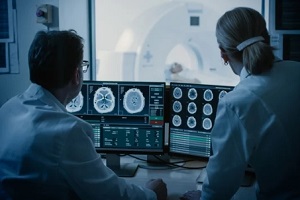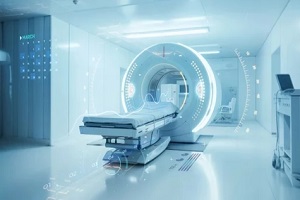Healthcare has always been about understanding the various complexities and unknowns of the human body. From basic stethoscopes to advanced MRI machines, our tools for diagnosis have come a long way. But now, we’re on the brink of another major leap forward—and the future of patient care is intertwined with massive innovations and leaps forward in medical imaging software.
These key advancements aren’t just about better image quality; they’re outright changing how medical professionals diagnose diseases, plan treatments, and even identify potential health issues before they become severe.
Today we’re going to explore the transformative impact of these vital medical imaging software breakthroughs and what they mean for healthcare as we know it.
AI-Powered Advancements In Radiology
 The past decade has seen an exponential increase in the overlap of artificial intelligence (AI) and radiology, representing a revolution in medical imaging software.
The past decade has seen an exponential increase in the overlap of artificial intelligence (AI) and radiology, representing a revolution in medical imaging software.
Historically, radiologists would have to manually review scans and images to diagnose conditions, depending largely on their overall training, years of expertise, and, occasionally, their intuition. But thanks to AI and advancements in data management and processing, vast databases of medical imagery can be analyzed rapidly, learning and refining diagnostic techniques based on millions of data points.
One of the most transformative benefits AI brings to radiology is the enhanced speed of diagnosis. In past traditional scenarios, it could take a radiologist several hours to go through a series of images, cross-referencing them with patient history and associated medical documentation along the way. But now, AI algorithms can sift through this data in seconds, highlighting potential areas of concern and streamlining the diagnostic process.
Furthermore, AI’s accuracy rates have been astonishing. For example, AI’s involvement in mammography has led to more accurate detection of breast cancer, ensuring that early-stage tumors are spotted and acted upon promptly. Additionally, AI systems, having been trained on vast image databases, can often detect subtle patterns or abnormalities that the human eye can easily miss.
While there may be concerns that AI could replace the role of radiologists, in reality, AI serves as a powerful assistant. It aids in the elimination of human errors which might arise due to fatigue or oversight.
The system may be able to flag potential issues in images, but it is ultimately the trained human eye that makes the final judgment, considering the broader context of patient history and clinical presentation. The prowess of AI isn’t just limited to breast cancer detection. For conditions such as prostate cancer, MRI analysis has been greatly enhanced with AI algorithms.
The ability to detect and quantify tumors, track their growth or reduction, and even predict their potential trajectory based on historical data is transforming prostate cancer treatment.
Moreover, AI’s capacity to cross-reference current images with historical ones means that the system can detect changes or developments in a patient’s condition over time, sometimes even before these changes become clinically significant.
MRIs Are Faster, Safer, & More Efficient Than Ever
Magnetic Resonance Imaging (MRI) has been a cornerstone in medical diagnostics for decades. Its ability to provide clear, detailed images of the body’s internal structures without the use of ionizing radiation has made it a preferred imaging method for many conditions.

This improved efficiency is particularly beneficial for certain patient demographics, such as children or individuals with mobility issues, who can find it challenging to remain stationary for extended periods.
Another significant innovation in MRI is Whole Body Magnetic Resonance Imaging (WB MRI). Recognized as an exceptionally sensitive imaging test, WBMRI facilitates the early detection of conditions including multiple myeloma. Providing comprehensive imaging quickly has substantial implications for both patient outcomes and healthcare economics.
Moreover, the introduction of AI algorithms to MRI analyses has further enhanced the technique’s capabilities. These algorithms can detect and highlight abnormalities in scans, sometimes even before they become clinically apparent. This accelerates the diagnostic process and ensures that patients receive timely interventions.
One often overlooked aspect of MRI advancements is the focus on patient comfort and experience. Traditional MRI machines, with their closed, tubular structures, often induce feelings of claustrophobia in some patients. Newer designs are addressing this by offering more open configurations, quieter operations, and faster scan times, reducing the time a patient spends within the machine.
Furthermore, some facilities incorporate ambient lighting, calming visuals, and even music options to create a more relaxed environment. As the technology continues to evolve, a holistic approach that considers both diagnostic precision and patient comfort is emerging as the new gold standard in MRI imaging.
Reducing Radiation Exposure With Advanced CT Scans
Computed Tomography scans, also known as CT scans, have long been celebrated for their ability to produce intricate, detailed images of internal organs and tissues.
However, the associated radiation exposure has always been a concern, prompting the need for technological advancements to address this challenge. This is where dual-energy CT scans stand out; a groundbreaking innovation that manages to cut radiation doses while providing high-resolution images.
These scans decrease radiation exposure and empower radiologists to differentiate between healthy and diseased tissues with heightened accuracy by utilizing two different radiation types. Beyond immediate patient safety, the broader implications of reduced radiation exposure are important to note.
Decreasing radiation doses means that patients requiring multiple scans over time, such as those with chronic conditions or under long-term medical surveillance, can be imaged more frequently without accumulating harmful radiation. This can potentially change protocols in cancer surveillance, long-term disease management, and even preventive screenings where frequent monitoring is advantageous.
Furthermore, with increased public awareness about radiation risks, advancements such as dual-energy CT scans can reassure patients and make them more amenable to recommended imaging, ensuring that diagnoses are timely and comprehensive. These kinds of technological strides, don’t just represent an advancement in imaging capabilities, but also a significant step forward in patient-centric care and health outcomes.
Bridging The Accessibility Gap With Teleradiology
The advances in teleradiology have rapidly transformed the field of medical diagnostics. Its pivotal role exists in the capability to transmit digital medical images, such as X-rays, CTs, MRIs, and ultrasounds, from one location to another.

The importance of teleradiology extends beyond just patient care. It offers healthcare professionals flexibility, allowing them to consult and collaborate with peers across the globe. In turn, this has helped optimize workflows, reduce total costs, and enhance overall patient outcomes. However, as with all innovative solutions available, the underlying platforms must be efficient, reliable, and cost-effective at scale.
Let’s explore a case study of how teleradiology is already proving its promise in the real world. Synergy, a veterinary-focused platform, faced significant challenges; their existing Teleradiology PaaS (Platform-as-a-Service) was becoming a significant bottleneck. With rising costs and decreasing efficiency, they were losing competitive ground.
Meanwhile, their competitors, leveraging faster and more reliable platforms, were providing superior service at a reduced cost. In a strategic move to reclaim their competitive edge, Synergy collaborated with Orases.
Armed with a vision to improve their services, Synergy brought their challenges to the table. Orases, with their extensive expertise in custom software development and UI/UX design, took on the mantle of transforming their problem into a tangible solution. The outcome of this collaboration was a state-of-the-art Teleradiology/Case Management & Billing platform.
Veterinarians could now seamlessly transmit DICOM images, comprising radiographs, ultrasounds, CT scans, and MRIs, to contracted radiologists for precise interpretation. This platform accelerated the diagnostic process and provided veterinarians with comprehensive PDF reports, ensuring prompt and effective patient care.
Integrating modern interfaces, cutting-edge technology, and secure connections, Synergy’s revamped platform stood as a testament to innovation done right. This not only reinstated Synergy’s competitive position but also underscored the profound impact of efficient teleradiology solutions in delivering exceptional medical care to patients.
3D Printing & Cloud Integration Represent The Next Frontiers
3D printing and cloud technologies are not only reshaping the way medical professionals approach patient care but also shifting paradigms in patient education and collaboration.
3D printing enables clinicians to craft tangible, patient-specific anatomical models, providing a visual and tactile tool that can enhance patient comprehension and foster more informed decision-making. It can dramatically improve surgical planning, medical education, and even the creation of bespoke prosthetics.

Cloud-based solutions are meeting this challenge head-on, facilitating instant sharing and collaboration among healthcare professionals worldwide. This increased connectivity is poised to elevate the standard of care, regardless of geographical constraints.
Securing The Future Of Healthcare With Medical Imaging Software
The progression of modern medicine is propelled in large part, by the various innovations and advancements occurring in medical imaging software and teleradiology.
These tools don’t just diagnose; they connect, empower, and transform patient care overall. The value of timely and precise diagnostics, especially in remote and underserved areas, cannot be overstated. But for teleradiology to truly realize its potential, the underlying platforms must be state-of-the-art, responsive, and reliable—this is where Orases can help.
Their collaboration with Synergy underscores the tangible impact that custom software solutions can have on refining and advancing teleradiology. In streamlining communication, enhancing data security, and improving overall efficiency, they’ve set a benchmark for what’s possible for the future of medical imaging software.
If you’re looking to be at the forefront of healthcare’s next revolution, consider partnering with Orases. With their expertise, the future of medical imaging software isn’t just bright; it’s transformative. Take a step into the future and discover how Orases can tailor custom software solutions to help supercharge your medical initiatives.






